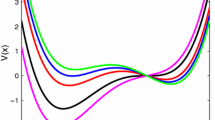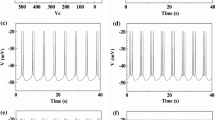Abstract
We study the emergence of in-phase and anti-phase synchronized rhythms in bursting networks of Hodgkin-Huxley-type neurons connected by inhibitory synapses. We show that when the state of the individual neuron composing the network is close to the transition from bursting into tonic spiking, the appearance of the network’s synchronous rhythms becomes sensitive to small changes in parameters and synaptic coupling strengths. This bursting-spiking transition is associated with codimension-one bifurcations of a saddle-node limit cycle with homoclinic orbits, first described and studied by Leonid Pavlovich Shilnikov. By this paper, we pay tribute to his pioneering results and emphasize their importance for understanding the cooperative behavior of bursting neurons. We describe the burst-duration mechanism of inphase synchronized bursting in a network with strong repulsive connections, induced by weak inhibition. Through the stability analysis, we also reveal the dual property of fast reciprocal inhibition to establish in- and anti-phase synchronized bursting.
Similar content being viewed by others
References
Rinzel, J., Bursting Oscillations in an Excitable Membrane Model, Ordinary and Partial Differential Equations (Dundee, 1984), B.D. Sleeman and R. J. Jarvis (Eds.), Lecture Notes in Math., vol. 1151, New York: Springer, 1985, pp. 304–316.
Rinzel, J., A Formal Classification of Bursting Mechanisms in Excitable Systems, Mathematical Topics in Population Biology, Morphogenesis and Neuroscience, E. Teramoto and M. Yamaguti (Eds.), Lecture Notes in Biomath., vol. 71, Berlin: Springer, 1987, pp. 267–281.
Rinzel, J. and Ermentrout, B., Analysis of Neural Excitability and Oscillations, Methods of Neural Modeling: From Synapses to Networks, C. Koch and I. Segev (Eds.), MIT Press, 1989, pp. 135–169.
Ermentrout, G.B. and Kopell, N., Parabolic Bursting in an Excitable System Coupled with a Slow Oscillation, SIAM J. Appl. Math., 1986, vol. 46, pp. 233–253.
Terman, D., Chaotic Spikes Arising from a Model of Bursting in Excitable Membranes, SIAM J. Appl. Math., 1991, vol. 51, pp. 1418–1450.
Wang, X. J., Genesis of Bursting Oscillations in the Hindmarsh-Rose Model and Homoclinicity to a Chaotic Saddle, Phys. D, 1993, vol. 62, nos. 1–4, pp. 263–274.
Bertram, R., Butte, M. J., Kiemel, T., and Sherman, A., Topological and Phenomenologial Classication of Bursting Oscillations, Bull. Math. Biol., 1995, vol. 57, pp. 413–439.
Izhikevich, E., Neural Excitability, Spiking and Bursting, Internat. J. Bifur. Chaos Appl. Sci. Engrg., 2000, vol. 10, pp. 1171–1266.
Belykh, V.N., Belykh, I.V., Colding-Joregensen, M., and Mosekilde, E. Homoclinic Bifurcations Leading to Bursting Oscillations in Cell Models, Eur. Phys. J. E. Soft Matter Biol. Phys., 2000, vol. 3, pp. 205–219.
Doiron, B., Laing, C., and Longtin, A., Ghostbursting: A Novel Neuronal Burst Mechanism, Comput. Neurosci., 2002, vol. 12, pp. 5–25.
Shilnikov, A. and Cymbalyuk, G., Homoclinic Bifurcations of Periodic Orbits en route from Tonic-Spiking to Bursting in Neuron Models, Regul. Chaotic Dyn., 2004, vol. 9, pp. 281–297.
Shilnikov, A., Calabrese, R., and Cymbalyuk, G., Mechanism of Bi-Stability: Tonic Spiking and Bursting in a Neuron Model, Phys. Rev. E, 2005, vol. 71, 056214, 9 p.
Shilnikov, A. and Cymbalyuk, G., Transition between Tonic-Spiking and Bursting in a Neuron Model via the Blue-Sky Catastrophe, Phys. Rev. Lett., 2005, vol. 94, 048101, 4 p.
Fröhlich, F. and Bazhenov, M., Coexistence of Tonic Firing and Bursting in Cortical Neurons, Phys. Rev. E, 2006, vol. 74, 031922, 7 p.
Chanell, P., Cymbalyuk, G., and Shilnikov, A., Origin of Bursting through Homoclinic Spike Adding in a Neuron Model, Phys. Rev. Lett., 2007, vol. 98, 134101, 4 p.
Wang, X.-J. and Rinzel, J., Alternating and Synchronous Rhythms in Reciprocally Inhibitory Model Neurons, Neural Comput., 1992, vol. 4, pp. 84–97.
Van Vreeswijk, C., Abbott, L. F., and Bard Ermentrout, G., When Inhibition Not Excitation Synchronizes Neural Firing, Comput. Neurosci., 1994, vol. 1, pp. 313–321.
Kopell, N. and Ermentrout, G. B., Mechanisms of Phase-Locking and Frequency Control, Handbook of Dynamical Systems, vol. 2, B. Fiedler (Ed.), Amsterdam: Elsevier, 2002, pp. 3–54.
Elson, R. C., Selverston, A. I., Abarbanel, H.D. I., and Rabinovich, M. I., Inhibitory Synchronization of Bursting Inbiological Neurons: Dependence on Synaptic Time Constant, J. Neurophysiol., 2002, vol. 88, pp 1166–1176.
Golomb D. and Rinzel, J., Clustering in Globally Coupled Inhibitory Neurons, Phys. Rev. E, 1993, vol. 48, pp. 4810–4814.
Somers, D. and Kopell, N., Rapid Synchronization through Fast Threshold Modulation, Biol. Cybernet., 1993, vol. 68, pp. 393–407.
Sherman, A., Anti-Phase, Asymmetric, and Aperiodic Oscillations in Excitable Cells: 1. Coupled Bursters, Bull. Math. Biol., 1994, vol. 56, pp. 811–835.
Terman, D., Kopell, N., and Bose, A., Dynamics of Two Mutually Coupled Slow Inhibitory Neurons, Phys. D, 1998, vol. 117, pp. 241–275.
Rubin, J. and Terman, D., Synchronized Activity and Loss of Synchrony among Heterogeneous Conditional Oscillators, SIAM J. Appl. Dyn. Sys., 2002, vol. 1, pp. 146–174.
Lewis, T. and Rinzel, J., Dynamics of Spiking Neurons Connected by Both Inhibitory and Electrical Coupling, Comput. Neurosci., 2003, vol. 14, pp. 283–309.
Rubin, J. and Terman, D., Geometric Singular Perturbation Analysis of Neuronal Dynamics, Handbook of Dynamical Systems, vol. 2, B. Fiedler (Ed.), Amsterdam: Elsevier, 2002, pp. 93–146.
Kopell, N. and Ermentrout, G. B., Chemical and Electrical Synapses Perform Complementary Roles in the Synchronization of Interneuronal Networks, Proc. Natl. Acad. Sci. USA, 2004, vol. 101, pp. 15482–15487.
Bondarenko, V.E., Cymbalyuk, G. S., Patel, G., DeWeerth, S.P., and Calabrese, R. L., Bifurcation of Synchronous Oscillations into Torus in a System of Two Reciprocally Inhibitory Silicon Neurons: Experimental Observation and Modeling, Chaos, 2004, vol. 14, pp. 995–1003.
Bem, T. and Rinzel, J., Short Duty Cycle Distabilizes a Half-Center Oscillator, by Gap Junctions Can Restabilize the Anti-Phase Pattern, J. Neurophysiol., 2004, vol. 91, pp. 693–703.
Cymbalyuk, G. S., Nikolaev, E. V., and Borisyuk, R.M., In-Phase and Anti-Phase Self-Oscillations in a Model of Two Electrically Coupled Pacemakers, Biol. Cybernet., 1994, vol. 71, pp. 153–160.
Belykh, I., de Lange, E., and Hasler, M., Synchronization of Bursting Neurons: What Matters in the Network Topology, Phys. Rev. Lett., 2005, vol. 94, 188101, 4 p.
Izhikevich, E.M., Synchronization of Elliptic Bursters, SIAM Rev., 2001, vol. 43, no. 2, pp. 315–344.
Van Vreeswijk, C. and Hansel, D., Patterns of Synchrony in Neural Networks with Spike Adaptation, Neural Comput., 2001, vol. 13, pp. 959–992.
Rabinovich, M. I., Varona, P., Selverston, A. I., and Abarbanel, H.D. I., Dynamical Principles in Neuroscience, Rev. Modern Phys., 2006, vol. 78, no. 4, pp. 1213–1265.
Belykh, I. and Shilnikov, A., When Weak Inhibition Synchronizes Strongly Desynchronizing Networks of Bursting Neurons, Phys. Rev. Lett., 2008, vol. 101, 078102, 4 p.
Kopell, N., Toward a Theory of Modelling Central Pattern Generators, Neural Control of Rhythmic Movements in Vertebrates, A.H. Cohen, S. Rossignol, and S. Grillner (Eds.), New York: Wiley, 1987, pp. 369–413.
Getting, P.A., Emerging Principles Governing the Operation of Neural Networks, Annu. Rev. Neurosci., 1989, vol. 12, pp. 185–204.
Marder, E. and Calabrese, R. L., Principles of Rhythmic Motor Pattern Generation, Physiol. Rev., 1996, vol. 76, no. 3, pp. 687–717.
Marder, E., Kopell, N., and Sigvardt, K., How Computation Aids in Understanding Biological Networks, Neurons, Networks, and Motor Behavior, P. S.G. Stein, A. Selverston, S. Grillner, and D. G. Stuart (Eds.), Cambridge: MIT Press, 1998, pp. 139–150.
Kristan, W. B., Calabrese, R. L., and Friesen, W.O., Neuronal Control of Leech Behavior, Progr. Neurobiol., 2005, vol. 76, pp. 279–327.
Kristan, W. B., and Katz, P., Form and Function in Systems Neuroscience, Curr. Biol., 2006, vol. 16, R828–R831.
Briggman, K.L. and Kristan, W. B., Multifunctional Pattern-Generating Circuits, Annu. Rev. Neurosci., 2008, vol. 31, pp. 271–294.
Katz, P. S., Tritonia, http://www.scholarpedia.org/article/Tritonia.
Brown, T.G., The Intrinsic Factors in the Act of Progerssion in the Mammal, Proc. R. Soc. Lond. B, 1911, vol. 84, pp. 308–319.
Brown, T.G., On the Nature of the Fundamental Activity of the Nervous Ventres: Together with an Analysis of the Conditioning of Rhythmic Activity in Progression, and a Theory of the Evolution of Function in the Nervous System, J. Physiol., 1914, vol. 48, pp. 18–46.
Canavier, C.C., Baxter, D.A., Clark, J. W., and Byrne, J. H., Control of Multistability in Ring Circuits of Oscillators, Biol. Cybernet., 1999, vol. 80, pp. 87–102.
Baxter, D.A., Lechner, H. A., Canavier, C. C., Butera, R. J., Franceschi, A. A., Clark, J.W., and Byrne, J. H., Coexisting Stable Oscillatory States in Single Cell and Multicellular Neuronal Oscillators, Oscillations in Neural Systems, D. S. Levine, V. R. Brown, V. T. Shirey (Eds.), Hillsdale, NJ: Erlbaum Associates, 1999, pp. 51–78.
Prinz, A. A., Bucher, D., and Marder, E., Similar Network Activity from Disparate Circuit Parameters, Nature Neurosci., 2004, vol. 7, pp. 1345–1352.
Shilnikov, A., Gordon, R., and Belykh, I., Polyrhythmic Synchronization in Bursting Network Motifs, Chaos, 2008, vol. 18, 037120, 13 p.
Cymbalyuk, G. S., Gaudry, Q., Masino, M. A., and Calabrese, R. L., Bursting in Leech Heart Interneurons: Cell Autonomous and Network Based Mechanisms, J. Neurosci., 2002, vol. 22, pp. 10580–10592.
Tobin, A.-E. and Calabrese, R. L., Endogenous and Half-Center Bursting in Morphologically-Inspired Models of Leech Heart Interneurons, J. Neurophysiol., 2006, vol. 96, pp. 2089–2106.
Jalil, S., Belykh, I., and Shilnikov, A., Fast Reciprocal Inhibition Can Synchronize Bursting Neurons, submitted for publication in Phys. Rev. E.
De Lange, E. and Kopell, N., Fast Threshold Modulation, Scholarpedia
Turaev, D.V. and Shilnikov, L.P., Blue Sky Catastrophe, Dokl. Math., 1995, vol. 51, pp. 404–407.
Shilnikov, A., Shilnikov, L.P., and Turaev, D.V., Blue Sky Catastrophe in Singularly Perturbed Systems, Mosc. Math. J., 2005, vol. 5, no. 1, pp. 269–282.
Lukyanov, V. and Shilnikov, L.P., On Some Bifurcations of Dynamical Systems with Homoclinic Structures, Dokl. Akad. Nauk SSSR, 1978, vol. 243, no. 1, pp. 26–29 [Soviet Math. Dokl., 1978, vol. 19, 1314–1318].
Author information
Authors and Affiliations
Corresponding author
Additional information
Dedicated to Leonid P. Shilnikov on the occasion of his 75th birthday
Rights and permissions
About this article
Cite this article
Belykh, I., Jalil, S. & Shilnikov, A. Burst-duration mechanism of in-phase bursting in inhibitory networks. Regul. Chaot. Dyn. 15, 146–158 (2010). https://doi.org/10.1134/S1560354710020048
Received:
Accepted:
Published:
Issue Date:
DOI: https://doi.org/10.1134/S1560354710020048




